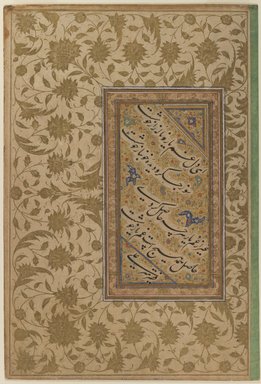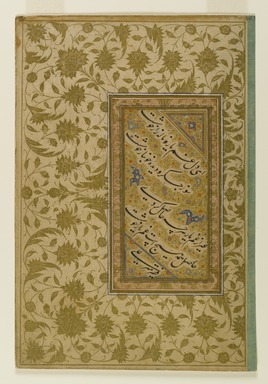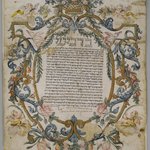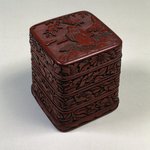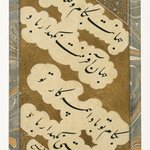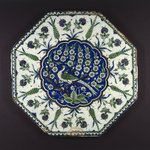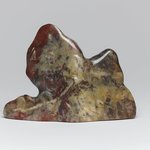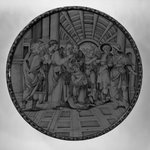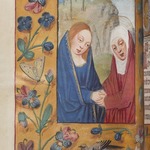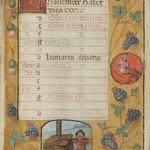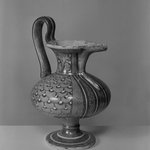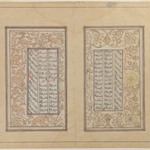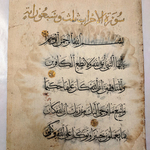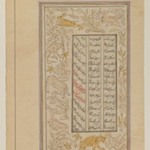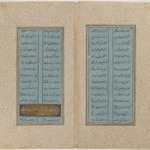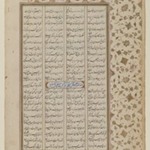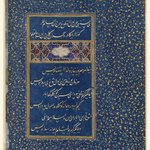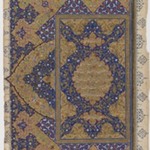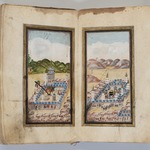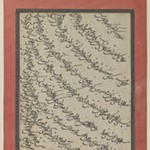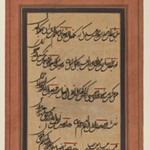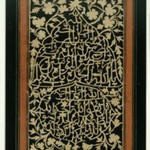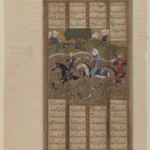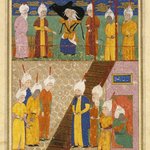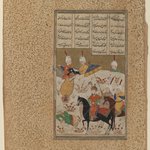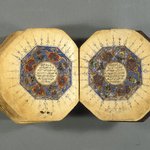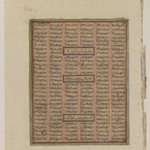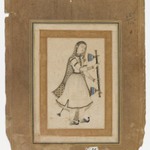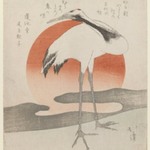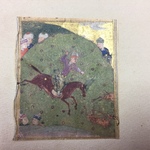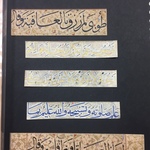Sample of Calligraphy in Persian Nasta'liq Script
Arts of the Islamic World
In the first centuries after the advent of Islam, Arabic calligraphy—alluding to the written word of God—was one of the main characteristics distinguishing the art of Islam from that of the preceding Byzantines and Sasanians in the Near East. In sixteenth-century Iran, calligraphy was a highly revered art form, visible in the public sphere in architectural inscriptions and, in more private and exclusive circles, collected by the court and wealthy elite to be assembled and enjoyed in albums. Samples such as the one shown here were often embellished with stylized floral and leaf patterns rendered in colorful pigments and gilding, remounted into beautifully ornamented and gilded margin papers, and bound together in albums and anthologies of poetry.
Calligraphy lessons comprised one of the many branches of a ruler's education, and some princes exhibited great talent for the art form. The signature following the skillfully executed verses on this page, however, suggests that a court calligrapher may have been responsible for this example. The lower left triangle reads, "faqīr Mir cAli [the poor Mir 'Ali]," which invites a possible attribution to the celebrated calligrapher Mir 'Ali Haravi (died 1544–45), active at the court in Herat until 1528, when he was captured and moved to Bukhara by the Uzbeks. One of the greatest masters of calligraphy of his time, Mir 'Ali was known to copy numerous manuscripts and poetic verses, some of which he even composed.
The verses read:
O hear, lamenting one's beloved and moaning with grief are a pleasure,
A tormented soul and bloodshot eyes [from weeping] are a pleasure.
If you have indulged in everything but the lamentation of your beloved,
All of that would amount to nothing—the anguish is what brings pleasure.
MEDIUM
Ink, opaque watercolors, and gold on paper
DATES
16th century
PERIOD
Safavid Period
DIMENSIONS
8 13/16 x 5 1/4 in. (22.4 x 13.3 cm)
(show scale)
SIGNATURE
Mir 'Ali [al-Husaini al-Haravi]
ACCESSION NUMBER
X629.6
CREDIT LINE
Brooklyn Museum Collection
MUSEUM LOCATION
This item is not on view
CAPTION
Ali Haravi. Sample of Calligraphy in Persian Nasta'liq Script, 16th century. Ink, opaque watercolors, and gold on paper, 8 13/16 x 5 1/4 in. (22.4 x 13.3 cm). Brooklyn Museum, Brooklyn Museum Collection, X629.6 (Photo: Brooklyn Museum, X629.6_IMLS_PS3.jpg)
IMAGE
overall, X629.6_IMLS_PS3.jpg. Brooklyn Museum photograph
"CUR" at the beginning of an image file name means that the image was created by a curatorial staff member. These study images may be digital point-and-shoot photographs, when we don\'t yet have high-quality studio photography, or they may be scans of older negatives, slides, or photographic prints, providing historical documentation of the object.
RIGHTS STATEMENT
No known copyright restrictions
This work may be in the public domain in the United States. Works created by United States and non-United States nationals published prior to 1923 are in the public domain, subject to the terms of any applicable treaty or agreement.
You may download and use Brooklyn Museum images of this work. Please include caption information from this page and credit the Brooklyn Museum. If you need a high resolution file, please fill out our online
application form (charges apply).
The Museum does not warrant that the use of this work will not infringe on the rights of third parties, such as artists or artists' heirs holding the rights to the work. It is your responsibility to determine and satisfy copyright or other use restrictions before copying, transmitting, or making other use of protected items beyond that allowed by "fair use," as such term is understood under the United States Copyright Act.
The Brooklyn Museum makes no representations or warranties with respect to the application or terms of any international agreement governing copyright protection in the United States for works created by foreign nationals.
For further information about copyright, we recommend resources at the
United States Library of Congress,
Cornell University,
Copyright and Cultural Institutions: Guidelines for U.S. Libraries, Archives, and Museums, and
Copyright Watch.
For more information about the Museum's rights project, including how rights types are assigned, please see our
blog posts on copyright.
If you have any information regarding this work and rights to it, please contact
copyright@brooklynmuseum.org.
RECORD COMPLETENESS
Not every record you will find here is complete. More information is available for some works than for others, and some entries have been updated more recently. Records are frequently reviewed and revised, and
we welcome any additional information you might have.
